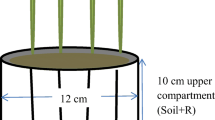Abstract
Polyphosphates vary in their rates of hydrolysis and degree of sorption by soil constituents, which could affect the efficiency of P recovery from these compounds by plants. In this study, four linear oligophosphates (P2, P3, P15, and P45) and one cyclic polyphosphate (trimetaphosphate) were tested in greenhouse experiments for their ability to supply P to plants, compared with that of the conventional P source, orthophosphate (P1). Annual ryegrass (Lolium multiflorum Lam.) and corn (Zea mays) were used as the indicator plants. Ryegrass was grown on four Iowa soils (Clarion, Webster, Primghar, and Ida), treated at the rates of 0, 20, 40, and 80 mg P kg−1 soil (1.8 kg of soil pot−1) and harvested four times at 30-day intervals. The soils of the control pots were recovered, repotted (150 g pot−1), and seeded with corn after treatment with polyphosphates at the same rates as given. The corn plants were harvested after 35 d. With all P sources, dry matter yield and P yield increased with increasing rates of P application for both ryegrass and corn. Statistical analysis (Duncan's Multiple Range Test) of P yields of ryegrass and corn grown in soils amended with the various P sources indicated that there were no P compounds that consistently showed significantly greater amounts of P recovery in plant tissue. Considering all the P sources and rates of P application, dry matter yield was significantly correlated (exponentially) with P uptake by ryegrass from all four soils. The dry matter yield of corn was significantly correlated (linearly) with rates of P application with all P sources, indicating that the effectiveness of a unit of P taken up by plants in increasing the dry matter yield was similar among the polyphosphates and the conventional P fertilizer, orthophosphate. Measurements of extractable P (Bray-Kurtz I on the acid Clarion, Webster, and Primghar soils and Olsen's test on the alkaline Ida soil) upon completion of each experiment indicated that the residual P effects were similar among the P compounds after the short cropping period with corn (35 days) and the long cropping period with ryegrass (120 days).
Similar content being viewed by others
References
Blanchar RW and Hossner LR (1969) Hydrolysis, sorption, and plant uptake of phosphorus from 32 corn belt soils treated with ortho, pyro, tripoly, and trimetaphosphate. Soil Sci Soc Am Proc 33:622–625
Bundy LG and Bremner JM (1972) A simple titrimetric method for determination of inorganic carbon in soils. Soil Sci Soc Am Proc 36:273–276
Busman LM (1984) Behavior of polyphosphates in soils. Ph.D dissertation. Iowa State University, Ames, IA
Chapman HD (1965) Cation-exchange capacity. In Black CA (ed.) Methods of Soil Analysis. Part 2. Chemical Analyses, pp 891–901. Am Soc Agron, Madison, WI
Dick RP and Tabatabai MA (1986) Hydrolysis of polyphosphates in soils. Soil Sci 142:132–140
Dick WA and Tabatabai MA (1977) An alkaline oxidation method for determination of total phosphorus in soils. Soil Sci Soc Am Proc 41:511–514
Dick WA and Tabatabai MA (1977) Determination of orthophosphate in aqueous solutions containing labile organic and inorganic phosphorus compounds. J Environ Qual 6:82–85
Engelstad OP and Allen SE (1971) Ammonium pyrophosphate and ammonium orthophosphate as phosphorus sources: Effects of soil temperature, placement, and incubation. Soil Sci Soc Am Proc 35:1002–1004
Engelstad OP and Terman GL (1980) Agronomic effectiveness of phosphate fertilizers. In: Khasawneh et al. (eds) The Role of Phosphorus in Agriculture, pp 311–324. Am Soc Agron, Madison WI
Hughes JD and Hashimoto I (1971) Triammonium pyrophosphate as a source of phosphorus for plants. Soil Sci Soc Am Proc 35:643–646
Kilmer VJ and Alexander LT (1949) Methods of making mechanical analysis of soil. Soil Sci 68:18–24
Knudsen D (1980) Recommended phosphorus tests. In Dahnke WC (ed.) Recommended Chemical Soil Test Procedures for the North Central Region, pp 14–16. N D Agric Exp Stn, Bull No. 499
Mebius LJ (1960) A rapid method for determination of organic carbon in soil. Anal Chim Acta 22:120–124
Murphy J and Riley JP (1962) A modified single solution method for the determination of phosphorus in natural waters. Anal Chim Acta 27:31–36
Nelson DW and Sommers LE (1973) Determination of total nitrogen in plant material. Agron J 65:109–112
Sommers LE and Nelson DW (1972) Determination of total phosphorus in soils: A rapid perchloric acid digestion procedure. Soil Sci Soc Am Proc 36:902–904
Sutton CD and Larsen S (1964) Pyrophosphate as a source of phosphorus for plants. Soil Sci 97:196–201
Sutton CD, Gunary D and Larsen S (1966) Pyrophosphate as a source of phosphorus for plants. II. Hydrolysis and initial uptake by a barley crop. Soil Sci 101:199–204
Author information
Authors and Affiliations
Rights and permissions
About this article
Cite this article
Dick, R.P., Tabatabai, M.A. Polyphosphates as sources of phosphorus for plants. Fertilizer Research 12, 107–118 (1987). https://doi.org/10.1007/BF01048912
Accepted:
Issue Date:
DOI: https://doi.org/10.1007/BF01048912




